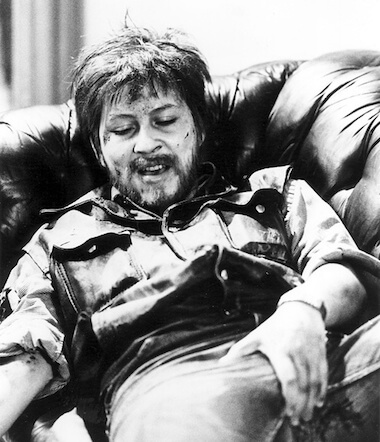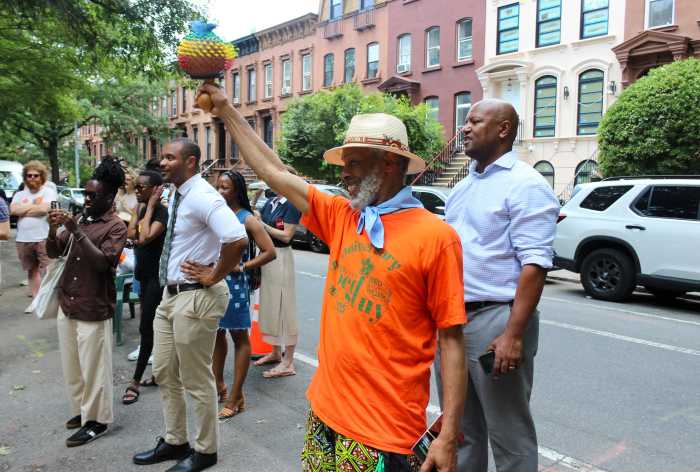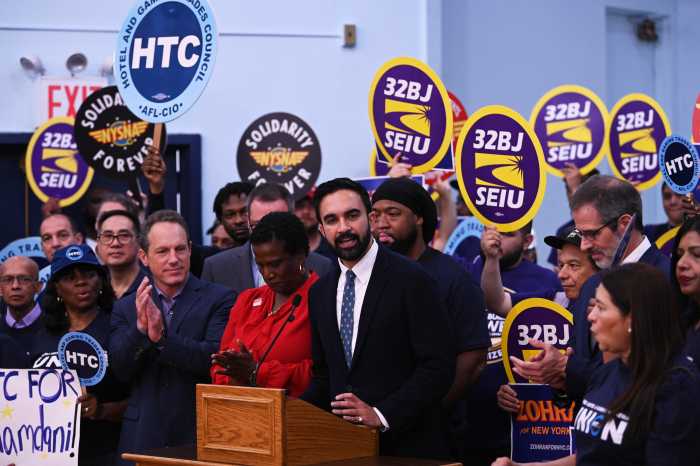Lee Kang-sheng in Tsai Ming-liang’s “Journey to the West,” playing the Anthology Film Archives May 5-7 only. | CINEMA GUILD
Out gay Taiwanese director Tsai Ming-liang has never had much American commercial success. Yet the critical kudos he’s received seem to be building momentum for his work. His film “Stray Dogs” was one of the most acclaimed Asian movies released in the US last year. Just last month, his 1992 debut “Rebels of the Neon God” got its first American release and the Museum of the Moving Image mounted a comprehensive Tsai retrospective. At the same time, his filmmaking is growing increasingly formalist, even “difficult.”
His latest, “Journey to the West,” leaves behind the socioeconomic concerns of “Stray Dogs” for a spiritual contemplativeness. It stars Tsai’s partner and constant star Lee Kang-sheng as a red-robed monk walking very slowly through Marseille. Tsai has made a series of six “Walker” shorts revolving around this character, based on seventh-century Buddhist monk Xuanzang (who spent 17 years walking through Asia), but “Journey to the West” is his most ambitious treatment of the Walker yet.
Tsai’s previous depictions of urban life have largely focused on its alienating and neurosis-inducing qualities. Even if a film like “The Hole,” inspired by fears of a Y2K apocalypse, ends on a hopeful note, that optimism is a brief note in a symphony of fear and anxiety. “Journey to the West” calls for patience, but it’s optimistic and relaxing. The Walker uses the spaces of Marseille for his own purposes and at his own pace.
Tsai Ming-liang expands on his “Walker” shorts with “Journey to the West”
In one of the film’s two lengthy set pieces, he very gradually walks down the right side of a busy stairwell, possibly a subway entrance. (Needless to say, a woman whips out her cell phone and takes a photo.) At first, he doesn’t even seem to be moving at all. In fact, it’s surprising that no one presses him to stop blocking half the stairwell. It's 10 minutes later that he’s finally descended the stairs.
Tsai never moves the camera. In exteriors, he seems to have filmed with natural light — one can tell that he placed the camera in particularly sunny spots in a few scenes. As far as I can tell, he didn’t hire professional extras. No one freaks out at the presence of the Walker, but one elderly woman stares into Tsai’s camera as she walks by and seemingly wants to talk to the filmmakers (but doesn’t). Tsai also uses long takes, although none is as challenging as Lee Kang-sheng’s 11-minute cabbage-eating scene in “Stray Dogs.” In one scene, the camera is upside down.
The first scene of “Journey to the West” is a five-minute close-up of French actor Denis Lavant’s face as he rests, evoking the radical openness of Andy Warhol’s “screen tests.” Lavant’s most famous roles — in Leos Carax’s “Mauvais Sang,” “Les Amants du Pont-Neuf” and “Holy Motors,” and Claire Denis’ “Beau Travail” — have called on his physicality, usually expressed through dance. Who could forget his dashing through Paris streets to the tune of David Bowie’s “Modern Love” in “Mauvais Sang”? Lavant’s character never speaks with the Walker but eventually becomes a follower of sorts. In the film’s second set piece, the two men walk very slowly through a crowded Marseille plaza, separated by about 50 feet.
No doubt one misses a lot of the subtleties of “Journey to the West” by not being a Buddhist. Yet the discipline of Lee’s performance and Tsai’s direction comes through loud and clear. The Walker strolls as if he were a snail. Walking comes so naturally and unconsciously to us that I’m sure it was quite difficult for Lee to learn how to perform it as “Journey to the West” requires (though at least he didn’t have to worry about line readings.)
Tsai’s films have frequently been compared to ‘60s European art cinema, particularly the work of Michelangelo Antonioni, and their references to Asian cinema have often been ignored in the US, partially because we haven’t been able to see films like the Taiwanese musicals quoted in “The Hole.”
“Journey to the West,” shot entirely in France and made largely with French financing, might be his most Buddhist film yet. At the same time, it has something in common with French films like Jacques Tati’s “Playtime” and Jacques Rivette’s “Celine and Julie Go Boating,” which reimagined the spaces of Paris streets as a playground. Perhaps it’s time for the Walker to come to Brooklyn.
JOURNEY TO THE WEST | Directed by Tsai Ming-liang | Cinema Guild | No dialogue | May 5-7 only | Anthology Film Archives, 32 Second Ave. at Second St.; anthologyfilmarchives.org



































